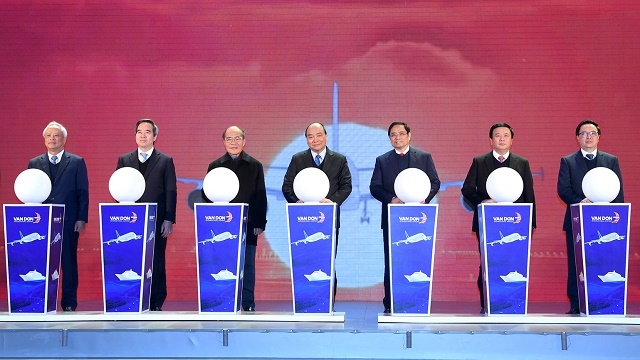



Prime Minister Nguyen Xuan Phuc (centre) and other delegates at the of the Van Don International Airport (Photo: VGP)
These infrastructural facilities have a combined investment capital of over VND20 trillion (over US$860 billion) invested in by the private investor, Sun Group.
Construction on Van Don International Airport started in 2015 on 288 hectares in Doan Ket commune, Van Don district. It is the first airport in Vietnam to operate under a build-operate-transfer (BOT) model at a cost of VND7.46 trillion.
The airport is capable of catering for Boeing 787, 777, and Airbus A350, A320. It is designed to have an annual capacity of 2-2.5 million passengers by 2020, which will increase to five million by 2030.
The airport is set to receive 500,000 passenger arrivals/departures in the first year of operation.
Meanwhile, the Hon Gai International Passenger Terminal, located in Bai Chay, Ha Long city, was built under a private-public partnership form between Sun Group and Quang Ninh province at a cost of VND1.03 trillion.
It was designed to have a 524-m quay that is able to receive two cruise ships with a capacity of up to 225,000 GT with a total of 8,460 passengers, including the crew, at the same time.
The port provides a five-star three-storey terminal covering 7,600 square metres and a harbor serving 250 tourist boats carrying visitors to the world heritage site Ha Long Bay.
To connect the airport and the port, the Ha Long-Van Don Expressway, built at a cost of VND11.85 trillion, was put into service. It helps shorten the travel time from Ha Long to Van Don to 50 minutes from the current 90 minutes.
Together with the Ha Long-Hai Phong highway, which opened to traffic in September 9, 2018, the Ha Long-Van Don Expressway stretching over 59 km, creates traffic connections in the economic triangle axis of Hanoi-Hai Phong-Quang Ninh and forms the Ha Noi-Hai Phong-Ha Long-Van Don-Mong Cai expressway route, contributing to easing traffic flow on National Highway 18. It will reduce the travel time from Hanoi to Van Don to 2 and a half hours from the current 5 hours.
Addressing the ceremony, PM Phuc reiterated the Party and States’ viewpoints regarding the attraction of private investments into developing infrastructural facilities and asked cities and provinces nationwide to study these projects for application in their localities, especially in the context that State resources remain limited.
He said these facilities will help Quang Ninh to strongly develop tourism, which is its spearhead economic sector.
He hailed the provincial authorities for their bold mindset in allowing private investors to join in developing major infrastructural facilities, turning the province into the fourth largest contributor to the State budget.
The leader asked the local government and Sun Group to work together to develop services in these facilities to attract more tourists, operate the facilities safely, and complete auxiliary works to maximise the efficiency of the freshly-operated facilities.
Reasserting the importance of the 10th Party Central Committee Resolution on developing the private economy, the Government leader asked the competent agencies at all levels to work to turn the private economy into an important driver of the national economy.